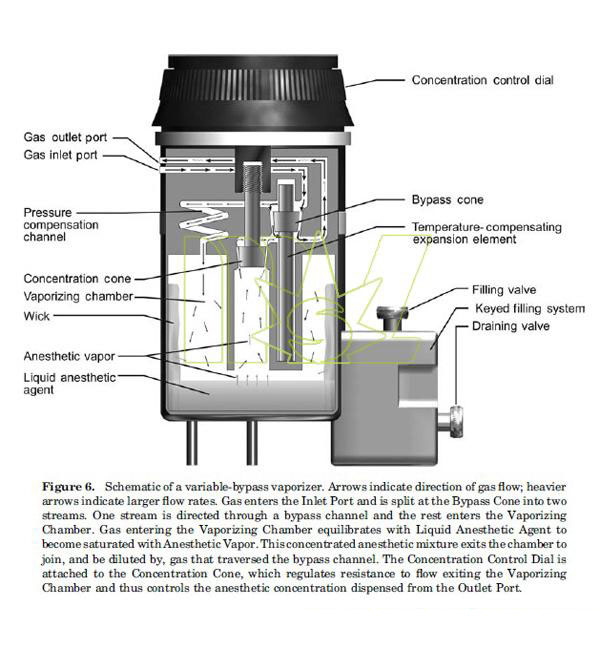Vaporizers are designed to add an accurate amount of volatilized anesthetic to the compressed gas mixture. Anesthetic vapors are pharmacologically potent, so low concentrations (generally < 5%) are typically needed. The volatilized gases contribute to the total gas flow rate and dilute the concentration of the other compressed gases. The user can calculate these effects since they are not displayed on the machine front panel; luckily, these are generally negligible and can be ignored. Even though most anesthesia machines have multiple vaporizers, only one is used at a time; interlock mechanisms prevent a vaporizer from being turned on when another vaporizer is in use. Vaporizers are anesthetic agent specific and keyed filling systems prevent filling a vaporizer with the wrong liquid anesthetic.
All current anesthesia machines have direct-setting vaporizers that add a specified concentration of a single anesthetic vapor to the compressed gas mixture. Variablebypass vaporizers are the most common (Fig. 6). 
In these, the inflowing compressed gas mixture is split into two streams. One stream is directed through a bypass channel and the other is directed into a chamber within the vaporizer that contains liquid anesthetic agent. The gas entering the vaporizing chamber becomes saturated with anesthetic vapor at a concentration that depends on the vapor pressure of the particular liquid anesthetic. For example, sevoflurane has a vapor pressure of 157 mmHg (20.9 kPa) at 20 8C, so the gas within the vaporizing chamber is about 20% sevoflurane (at sea level). This highly concentrated anesthetic mixture exits the chamber (now, at a flow rate greater than that entering the chamber, due to the addition of anesthetic vapor) to join, and be diluted by, gas that traversed the bypass channel. A dial on the vaporizer controls the delivered anesthetic concentration by regulating the resistance to flow along each path. For example, setting a sevoflurane vaporizer to a dialed concentration of 1% splits the inflowing compressed gas mixture so that one-twenty-fourth of the total is directed through the vaporizing chamber and the remainder is directed through the bypass. Direct-reading variable-bypass vaporizers are calibrated for a specific agent, since each anesthetic liquid has a different vapor pressure. Vapor pressure varies with temperature, so vaporizers are temperature compensated; at higher temperatures, a temperature sensitive valve diverts more gas through the bypass channel. Vaporizers are designed to ensure that the gas within the liquid-containing chamber is saturated with anesthetic vapor. A cotton wick within the chamber promotes saturation by increasing the surface area of the liquid. Thermal energy is required for liquid vaporization (heat of vaporization). To minimize cooling of the anesthetic liquid, vaporizers are constructed of metals with high specific heat and high thermal conductivity so that heat is transferred easily from the surroundings. The output of variable-bypass vaporizers varies with barometric pressure; delivered concentration increases as barometric pressure decreases.
Desflurane vaporizers are designed differently because desflurane has such a high vapor pressure (664 mmHg, or 88.5 kPa, at 20 8C) and low boiling point (22.8 8C). Uncontrollably high output concentrations could easily occur if desflurane were administered at room temperature froma variable-bypass vaporizer. In a desflurane vaporizer, the liquid desflurane is electrically heated to a controlled temperature of 39 8C within a pressure-tight chamber. At this temperature, the vapor pressure of desflurane is 1500 mmHg (200 kPa) and the anesthetic vapor above the liquid is a compressed gas. The concentration dial on the vaporizer regulates a computer-assisted flow proportioning mechanism that meters pressurized desflurane into the incoming gas mixture to achieve a set output concentration of desflurane vapor. Room temperature does not affect the output concentration of the vaporizer, nor does barometric pressure. The vaporizer requires electrical power for the heater, the onboard computer, and two electronic valves.




 Price is 8-20% Lower Than Other
Price is 8-20% Lower Than Other






